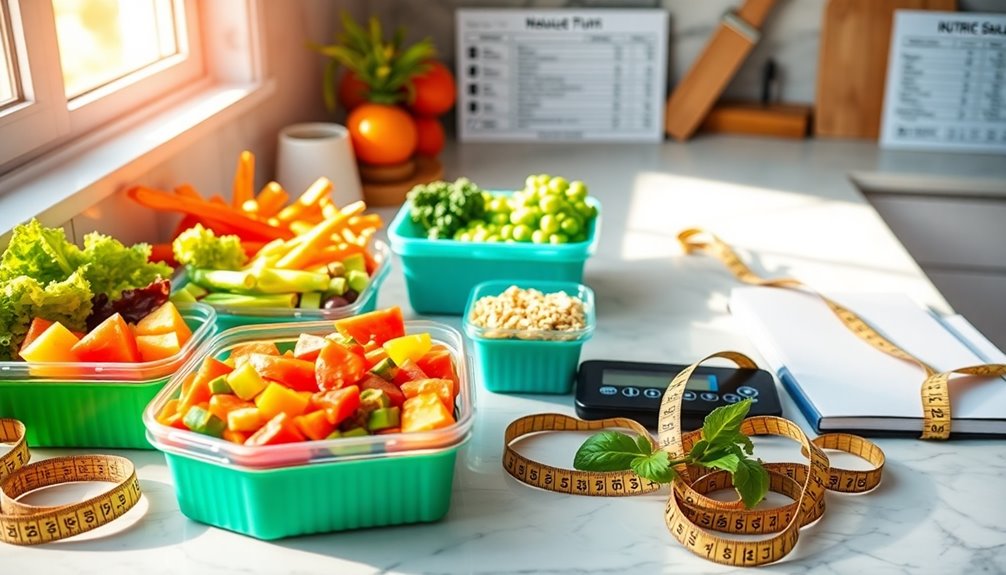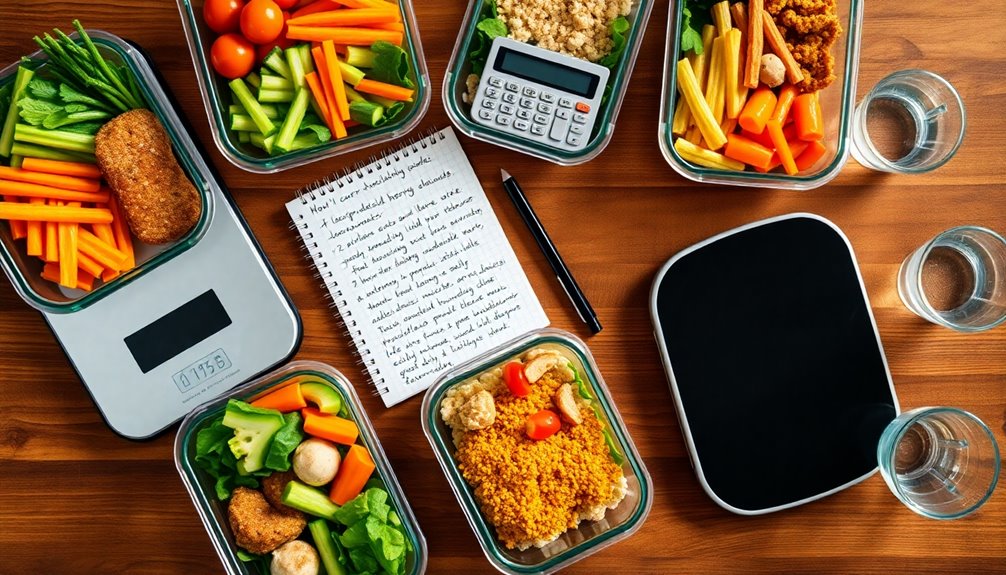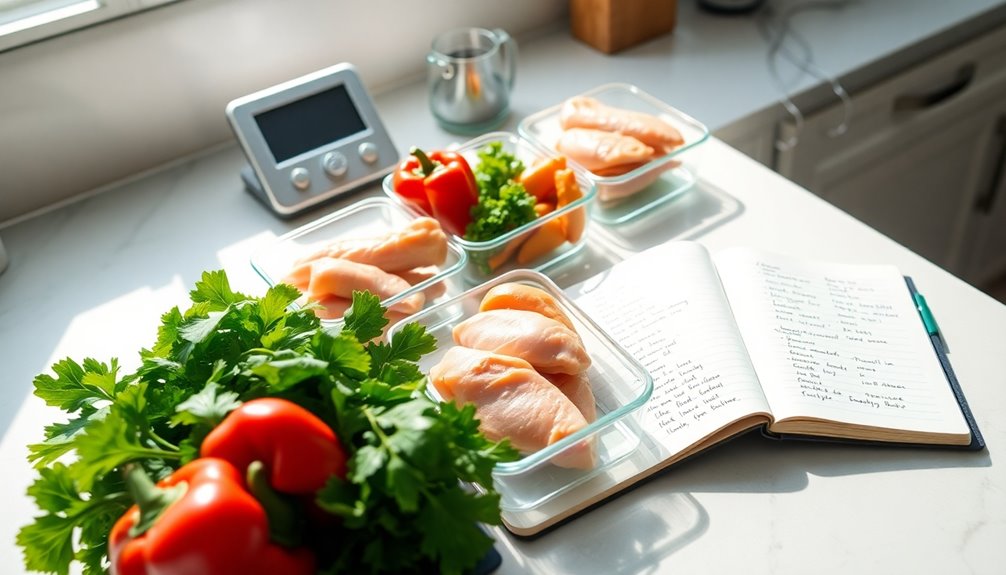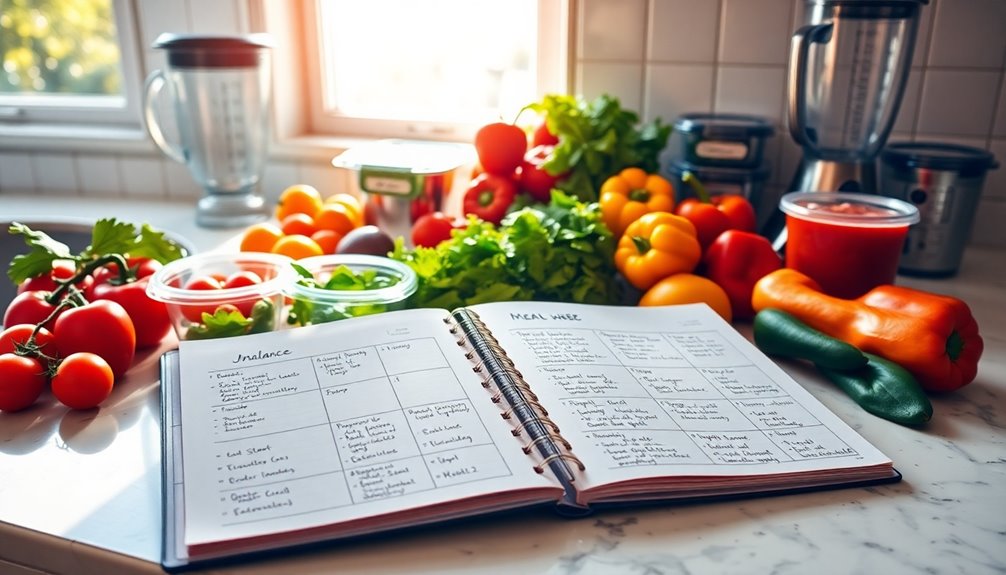To create a meal plan that fits your fitness goals, start by clearly defining those goals – whether it's weight loss, muscle gain, or health improvement. Calculate your Total Daily Energy Expenditure (TDEE) to determine your caloric needs. Focus on balanced meals containing lean proteins, complex carbs, and healthy fats. Incorporate a variety of colors from fruits and vegetables for essential nutrients. Prepare a shopping list to stay organized and consider batch cooking to save time. Finally, track your progress and adjust portions based on your results. As you refine your plan, you'll uncover strategies to enhance your journey ahead.
Key Takeaways
- Define your fitness goals, such as weight loss or muscle gain, to tailor your meal plan accordingly.
- Calculate your Total Daily Energy Expenditure (TDEE) to determine your caloric needs for your specific goals.
- Prioritize macronutrient ratios by including lean proteins, complex carbohydrates, and healthy fats in your meals.
- Plan diverse and nutrient-dense meals to keep your diet exciting and satisfying while promoting adherence.
- Monitor your progress and adjust your meal plan based on results and body cues to ensure effectiveness.
Assess Your Fitness Goals

When it comes to creating a meal plan that aligns with your fitness goals, the first step is to assess what those goals actually are. You need to be clear about whether you want to lose weight, build muscle, or improve overall health. This clarity will help you in setting priorities.
For instance, if weight loss is your goal, you'll focus on calorie control and nutrient-dense foods. On the other hand, muscle gain requires a higher protein intake and possibly increased caloric consumption.
As you define your goals, consider short-term and long-term objectives. Short-term goals might include fitting into a certain pair of jeans or lifting a specific weight, while long-term goals could involve maintaining a healthy lifestyle or participating in a fitness competition. Once you establish these, you can start tailoring your meal plan to meet those specific needs.
Don't forget the importance of tracking progress. Regularly checking in on how your body responds to your meal plan can provide valuable insights. You might keep a food diary or use an app to log your meals and workouts. This way, you can see what's working and what isn't, allowing you to make informed adjustments. Additionally, consider using progress tracking tools from resources like the Custom Keto Diet Plan to help you stay on track.
Engage with communities, whether online or in-person, to share your journey and gain support. Remember, you're not alone in this—everyone's working toward their own goals, and connecting with others can make the process more enjoyable and effective.
Understand Nutritional Needs

Understanding your nutritional needs is crucial in tailoring a meal plan that supports your fitness goals. To create an effective meal plan, you need to grasp the importance of macronutrient distribution and portion control. Here's how to start:
- Identify Your Goals: Are you aiming to lose weight, build muscle, or maintain a healthy lifestyle? Your goals will determine your macronutrient distribution—essentially the ratio of carbohydrates, proteins, and fats in your diet.
- Calculate Macronutrient Ratios: For muscle gain, you might target a higher protein intake. Conversely, if you're focusing on weight loss, increasing healthy fats and reducing carbs may be advantageous. The general guideline is often 40% carbs, 30% protein, and 30% fat, but this can vary based on individual needs.
- Practice Portion Control: Understanding portion sizes can help prevent overeating and guarantee you're getting the right amounts of each macronutrient. Use measuring cups or a food scale to help keep your portions in check.
- Listen to Your Body: Pay attention to how different foods make you feel. Adjust your meal plan based on your energy levels and how well you're recovering from workouts. Additionally, incorporating Keto diet principles can further enhance your nutritional approach for optimal results.
Calculate Daily Caloric Intake

Calculating your daily caloric intake is an essential step in creating an effective meal plan that aligns with your fitness goals. To start, you need to determine how many calories your body requires each day. This number is influenced by factors like age, gender, weight, height, and activity level. Online calculators can help you estimate your Total Daily Energy Expenditure (TDEE), which is your maintenance level.
Once you know your TDEE, you can adjust for your specific goals. If you're aiming for weight loss, you'll want to create a caloric deficit by consuming fewer calories than your TDEE.
Conversely, if you're looking to gain muscle, you'll need a surplus.
Next, consider macronutrient ratios—how you divide your calories among proteins, fats, and carbohydrates. A common starting point is 40% carbs, 30% protein, and 30% fat, but you can tweak these based on your preferences and how your body responds.
Don't forget about meal timing and nutrient timing. Eating at regular intervals can help manage hunger and energy levels. Prioritizing nutrient timing, particularly around workouts, can enhance recovery and muscle growth, ensuring you're fueling your body when it needs it most. Additionally, optimizing your oxygen intake can lead to burning an extra 3.5 pounds of body fat per month, supporting your overall fitness goals.
Choose Balanced Meals

With your daily caloric intake established, the next step is to choose balanced meals that align with your fitness goals. Balanced meals help you achieve nutrient balance while practicing portion control, ensuring you get the right amount of macronutrients and micronutrients your body needs. Here's how to create meals that work for you:
- Include Protein: Aim to fill a quarter of your plate with lean protein sources like chicken, fish, tofu, or legumes. Protein supports muscle repair and growth, which is essential for fitness enthusiasts.
- Add Whole Grains: Choose whole grains such as quinoa, brown rice, or whole-grain bread to provide complex carbohydrates. These grains fuel your workouts and help maintain energy levels throughout the day.
- Incorporate Fruits and Vegetables: Fill half your plate with a variety of colorful fruits and vegetables. They're packed with vitamins, minerals, and antioxidants, supporting overall health and recovery.
- Healthy Fats Matter: Don't forget about healthy fats like avocados, nuts, and olive oil. These fats are essential for hormone production and can enhance your meal's taste, making it satisfying.
Plan for Variety

To effectively meet your fitness goals, planning for variety in your meal options is essential. Eating a diverse range of foods not only keeps your meals exciting but also ensures you get a well-rounded intake of nutrients. This approach can help you stay committed to your plan and avoid the monotony that often leads to burnout. Additionally, incorporating whole food sources of protein in your meals can enhance satiety and provide essential amino acids for muscle synthesis.
Consider creating meals with different flavor combinations that excite your taste buds. For example, if you're trying to adhere to dietary restrictions, you can still enjoy a rich array of dishes. Here's a table to help inspire your meal planning:
| Flavor Combination | Meal Idea |
|---|---|
| Sweet & Spicy | Honey-glazed chicken with jalapeños |
| Savory & Citrusy | Lemon-herb quinoa salad with roasted veggies |
| Creamy & Crunchy | Avocado toast topped with pumpkin seeds |
| Bold & Fresh | Cilantro-lime shrimp tacos with mango salsa
Prepare a Shopping List

A well-organized shopping list is an essential tool for staying on track with your meal plan and fitness goals. By preparing a shopping list, you not only streamline your grocery trips but also guarantee you have everything needed to create balanced meals. Here's how to craft an effective list:
- Review your meal plan: Look through your week's recipes to see what ingredients you'll need. This helps you avoid impulse buys and stick to your goals.
- Identify ingredient substitutions: If you're missing an item, think of alternatives that still align with your nutritional needs. For example, if a recipe calls for quinoa, you might use brown rice instead. Being flexible can save you time and money while keeping your meals interesting.
- Categorize items: Group similar items together, such as produce, dairy, and proteins. This makes your shopping trip more efficient and reduces the chances of forgetting essentials.
- Stick to the list: Once you've got your list, focus on purchasing only what's on it. This discipline helps you resist the temptation of unhealthy snacks or items that don't fit your meal plan.
Incorporating these strategies into your shopping routine will make a significant difference in your journey toward achieving your fitness goals. You'll feel empowered knowing you're making conscious choices that support your health, and you'll develop a sense of belonging within a community that values mindful eating. Additionally, choosing plant-based ingredients can offer significant health benefits, including lower chances of cardiovascular disease. Happy shopping!
Meal Prep Techniques

Now that you've got your shopping list ready, it's time to put those ingredients to good use through effective meal prep techniques. By implementing these methods, you can save time and money while ensuring you stick to your meal plan.
First, consider batch cooking. Preparing large quantities of food at once means you won't have to cook every day. Cook grains, proteins, and vegetables in bulk, then portion them out for the week. This is a fantastic time-saving strategy that keeps you on track with your fitness goals.
Next, opt for budget-friendly options like seasonal produce. Not only are these ingredients typically cheaper, but they also taste fresher and are packed with nutrients. Combine these with pantry staples like beans and whole grains to create nutritious meals without breaking the bank.
Don't forget about storage! Invest in good-quality glass containers for easy reheating and to help you see what you have at a glance. Organizing your fridge also makes it easier to grab healthy options when you're hungry.
Lastly, try using a slow cooker or an Instant Pot. These tools can transform tough cuts of meat and hearty vegetables into delicious meals with minimal effort. Set them up in the morning, and by dinner, you'll have something nutritious waiting for you. Additionally, incorporating mini band workouts into your routine can complement your meal plan by enhancing muscle tone and strengthening your body.
Monitor and Adjust Your Plan

Monitoring your meal plan is essential for achieving your fitness goals. It's not just about creating a plan but also about following through and making adjustments along the way. Here's how you can effectively monitor and adjust your meal plan:
- Track Your Progress: Keep a journal or use an app to log your meals, workouts, and any changes in your weight or measurements. This'll give you a clear picture of what's working and what's not.
- Listen to Your Body: Pay attention to how your body feels after meals. Are you energized or sluggish? If you're consistently feeling fatigued, it might be time to reassess your food choices.
- Adjust Portions: If you're not seeing the results you want, consider adjusting portions. Don't be afraid to experiment with different serving sizes to find what suits your needs best.
- Make Changes as Needed: Fitness is a journey, and your meal plan should evolve with you. If you find certain foods aren't satisfying or aren't helping you reach your goals, swap them out for healthier options. Additionally, consider integrating a structured program like the 3X Diet System, which offers customized meal plans tailored to your specific needs and goals.
Frequently Asked Questions
How Often Should I Change My Meal Plan?
You should consider changing your meal plan every 4 to 8 weeks, depending on your progress and how your body responds. Long-term consistency is key, so stick with what works for you initially.
However, if you're adjusting macros to better align with your fitness goals, don't hesitate to make changes sooner. Listening to your body and keeping track of your results can help guarantee you stay on the right path.
Can I Indulge in Treats While Meal Planning?
Absolutely, you can indulge in treats while meal planning! Moderating treats is key to balancing cravings without feeling deprived. Allow yourself small portions of your favorite snacks occasionally; it keeps your diet enjoyable and sustainable.
Research shows that incorporating treats can boost adherence to your meal plan, helping you stay on track. Remember, it's all about balance—enjoying those treats can actually support your overall goals while making your meals more satisfying.
How Do I Handle Eating Out on My Meal Plan?
When you're dining out, it's important to stay mindful of your meal plan. Think of it as maneuvering a social event; you can still enjoy yourself while making smart choices.
Look for grilled options or salads, and don't hesitate to ask for modifications. Portion control helps, too—consider sharing dishes or opting for smaller portions.
What if I Have Food Allergies or Intolerances?
If you have food allergies or intolerances, customizing your meal plan is essential. Start by identifying safe ingredients and explore substitutions or alternatives that work for you.
For instance, if you're lactose intolerant, try almond milk instead of cow's milk. Make adjustments to recipes, swapping out problematic foods for ones that fit your needs.
Can Meal Planning Help With Weight Loss or Muscle Gain?
Imagine sculpting your body like a master artist molds clay. Meal planning plays a crucial role in your journey, helping you achieve that macronutrient balance essential for weight loss or muscle gain. By practicing portion control and tracking calories, you guarantee your food fuels your goals.
Prioritizing protein intake, you'll build muscle while shedding fat. With a well-structured plan, you create a community of support, turning your fitness aspirations into reality.
Conclusion
As you begin on your meal planning adventure, remember that each choice you make brings you closer to your fitness goals. Stay flexible and open to adjustments, as your needs might change along the way. Don't underestimate the power of a well-organized plan—it's the key to revealing your potential. Will you stick to it and see the results you desire? The answer lies in your commitment, and the path to success is just a meal away.



